Table of Contents
- Introduction
- Editor’s Choice
- Organic Packaged Food Market Statistics
- Share of Organic Packaged Food in Overall Sector – By Product Category
- Leading Organic Packaged Food Brands – By Brand Awareness
- Global Organic Food Sales Statistics
- Organic Packaged Food and Beverage Consumption Statistics
- Local Certified Organic Food Produce Prices
- Leading Performers in The Organic Packaged and Prepared Food Category
- Demographics of Organic Packaged Food Consumers Statistics
- Consumer Behaviour and Perceptions
- Challenges and Key Considerations
- Regulations for Organic Packaged Food in Various Nations
- Recent Developments
- Conclusion
- FAQs
Introduction
Organic Packaged Food Statistics: Organic packaged food encompasses a wide range of products meeting strict organic farming standards, such as the USDA Organic certification in the United States or the European Commission’s regulations in the EU.
These foods feature ingredients sourced from organic farms and grown without synthetic pesticides, fertilizers, GMOs, or irradiation.
Packaging typically includes labels indicating organic certification, ensuring consumers of the product’s adherence to these standards.
While organic foods may offer nutritional benefits and align with sustainability and health-conscious consumer preferences, challenges like higher production costs and limited ingredient availability persist.
Nonetheless, the sector continues to grow globally, driven by increased consumer awareness and demand for natural, sustainable options.
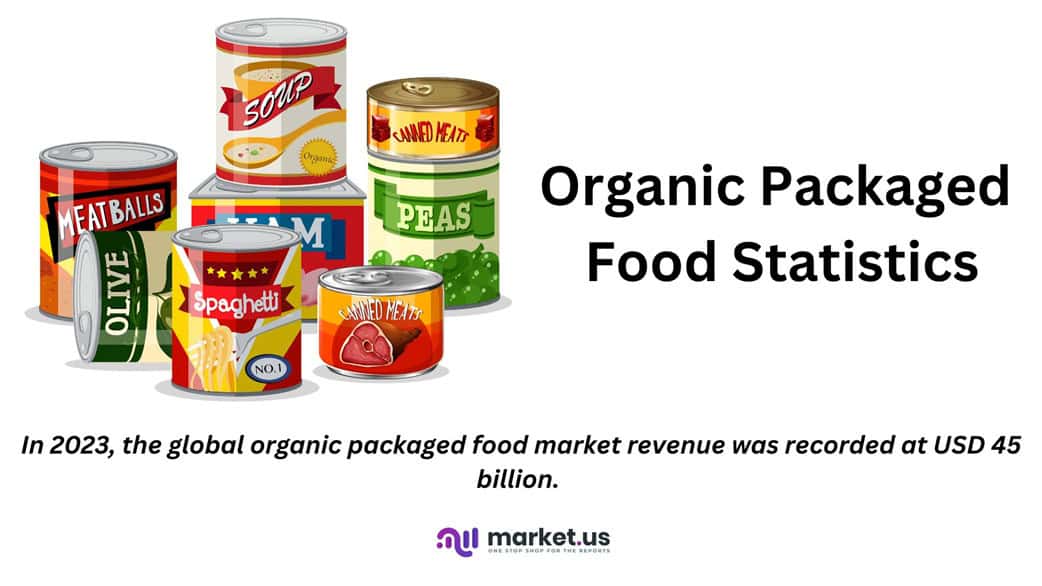
Editor’s Choice
- In 2023, the global organic packaged food market revenue was recorded at USD 45 billion.
- In the global organic packaged food market, Amy’s Kitchen holds a leading position with a market share of 23%.
- The global organic packaged food market is predominantly led by North America, which holds a commanding 51.0% market share.
- In 2023, the leading organic food brands in the United States, ranked by brand awareness, showcased notable market recognition. Trader Joe’s led with a brand awareness of 72%.
- The COVID-19 pandemic saw a surge in demand for organic food, with sales soaring to USD 120.65 billion in 2020.
- The majority of Americans are opting for organic foods due to health concerns, with 55% believing organic fruits and vegetables are superior for one’s well-being.
- Approximately 72% of American adults consider the price difference between organic and conventionally grown foods when deciding whether to purchase organic.
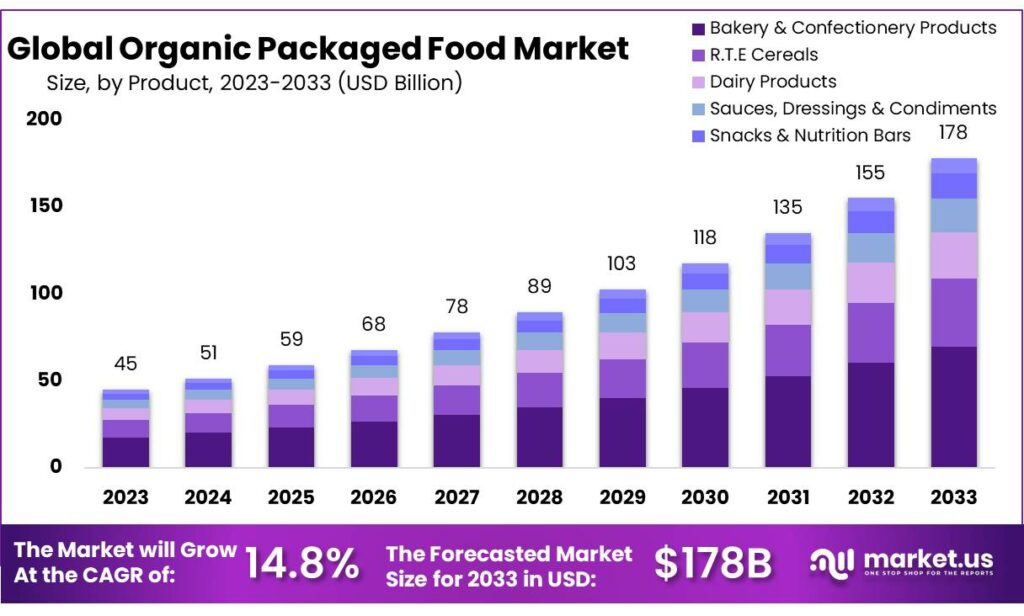
Organic Packaged Food Market Statistics
Global Organic Packaged Food Market Size Statistics
- The global organic packaged food market has exhibited substantial growth over the past decade at a CAGR of 14.8%.
- In 2023, the market revenue was recorded at USD 45 billion.
- This figure is projected to rise steadily, reaching USD 51 billion in 2024 and further expanding to USD 59 billion in 2025.
- The upward trend continues, with the market expected to generate USD 68 billion in 2026 and USD 78 billion in 2027.
- By 2028, the revenue is anticipated to climb to USD 89 billion, subsequently increasing to USD 103 billion in 2029.
- The market is forecasted to grow significantly, achieving USD 118 billion in 2030 and USD 135 billion in 2031.
- The most substantial growth is projected for 2032, with an expected market revenue of USD 155 billion.
- This consistent growth trajectory underscores the expanding consumer preference for organic packaged foods.
(Source: market.us)
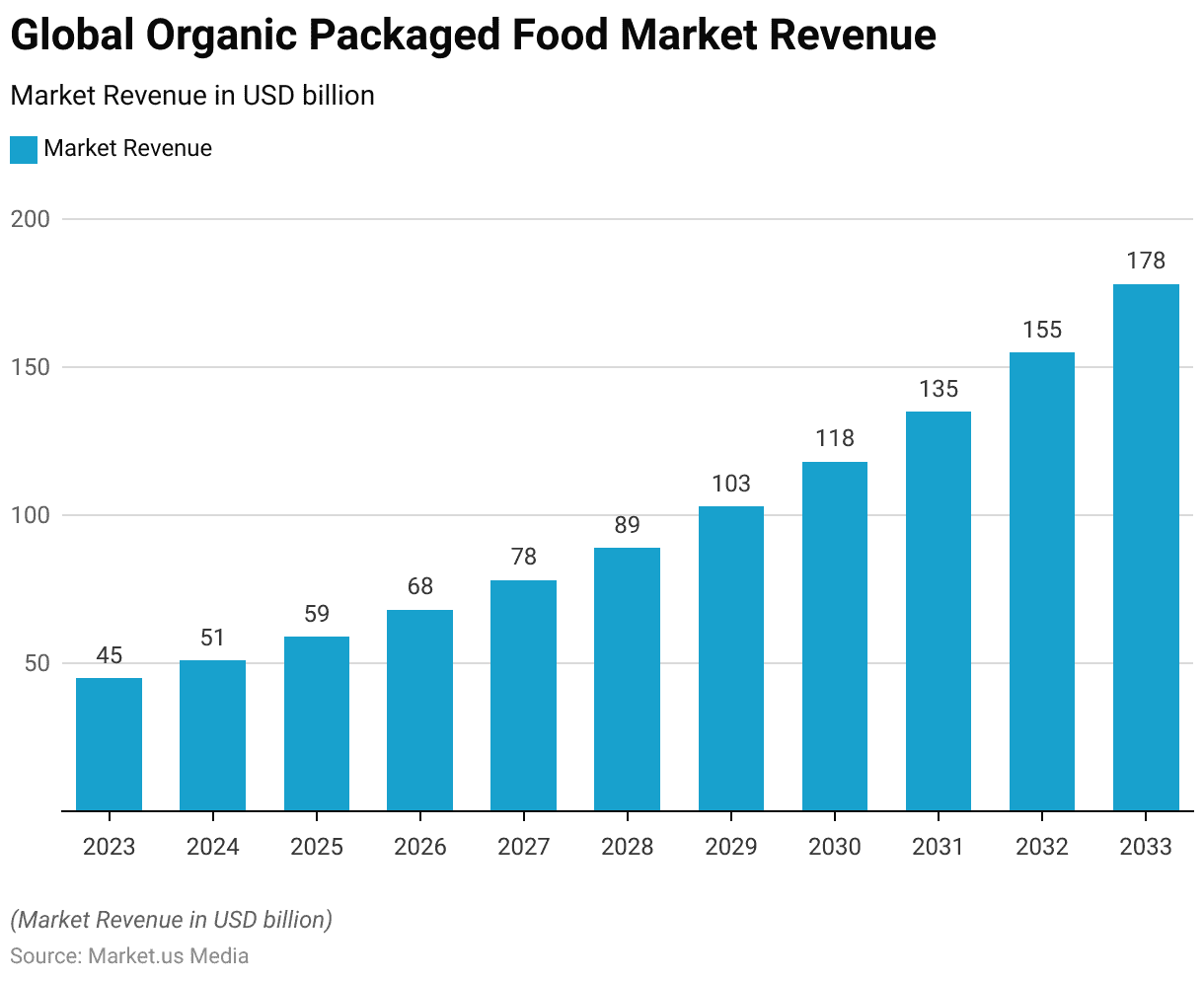
Competitive Landscape of the Global Organic Packaged Food Market Statistics
- In the global organic packaged food market, Amy’s Kitchen holds a leading position with a market share of 23%.
- Albert’s Organics, Inc. follows with a 17% share, while The Whitewave Foods Company accounts for 12% of the market.
- Hain Celestial Group, General Mills Inc., and The Kellogg Company each possess a 10% share.
- Campbell Soup Company captures 8% of the market, with other key players collectively holding an 11% share.
- This distribution highlights the competitive landscape, with a few major companies dominating the market while several other players maintain a significant presence.
(Source: market.us)
Take advantage of our unbeatable offer - buy now!

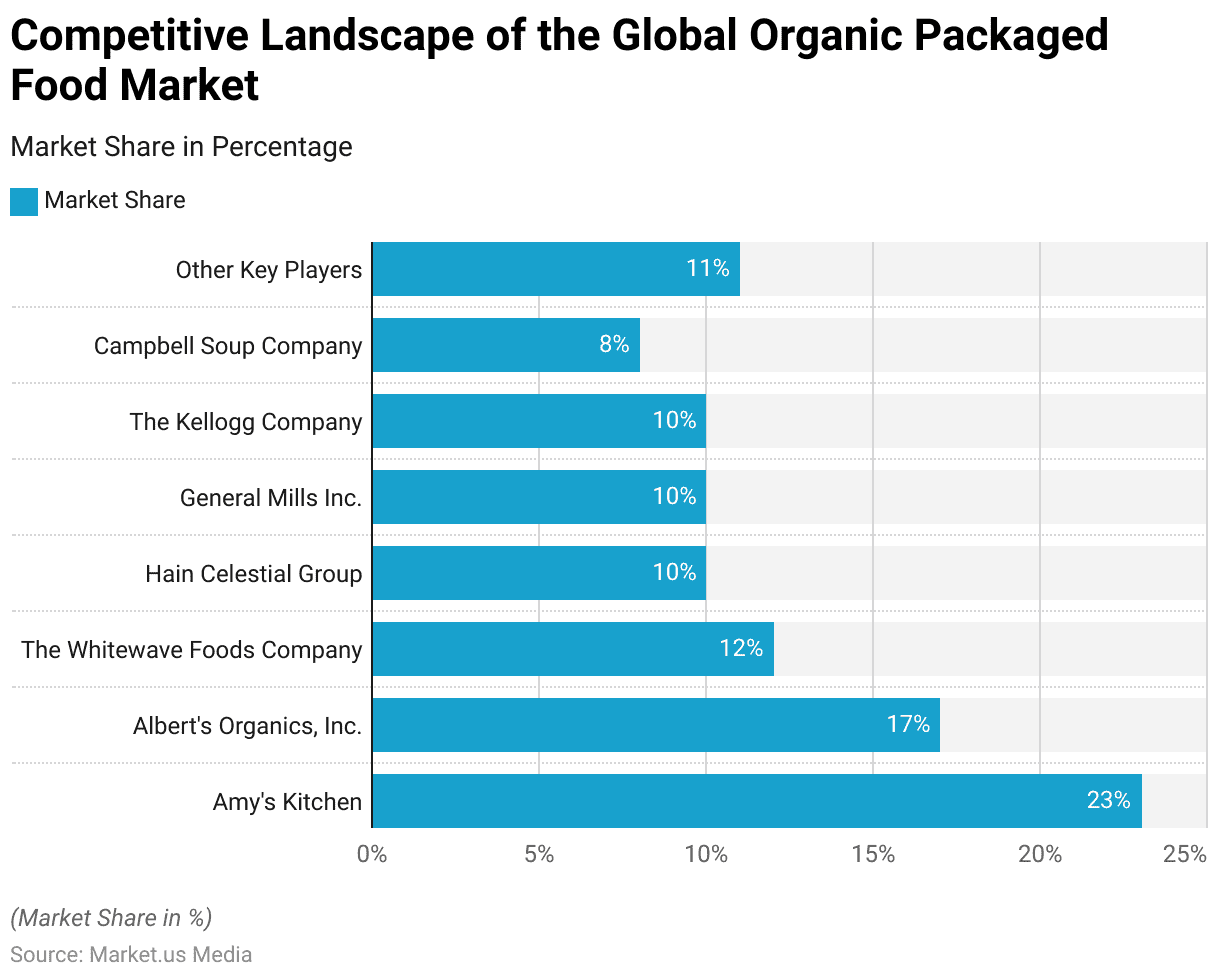
Regional Analysis of the Global Organic Packaged Food Market Statistics
- The global organic packaged food market is predominantly led by North America, which holds a commanding 51.0% market share.
- Europe follows with a 21.0% share, reflecting strong consumer demand in the region.
- The Asia-Pacific (APAC) region accounts for 18.0% of the market, indicating significant growth potential.
- South America holds a 6.0% share, while the Middle East and Africa (MEA) region captures 4.0% of the market.
- This distribution underscores the regional disparities in market penetration and highlights the dominant role of North America in the global organic packaged food sector.
(Source: market.us)
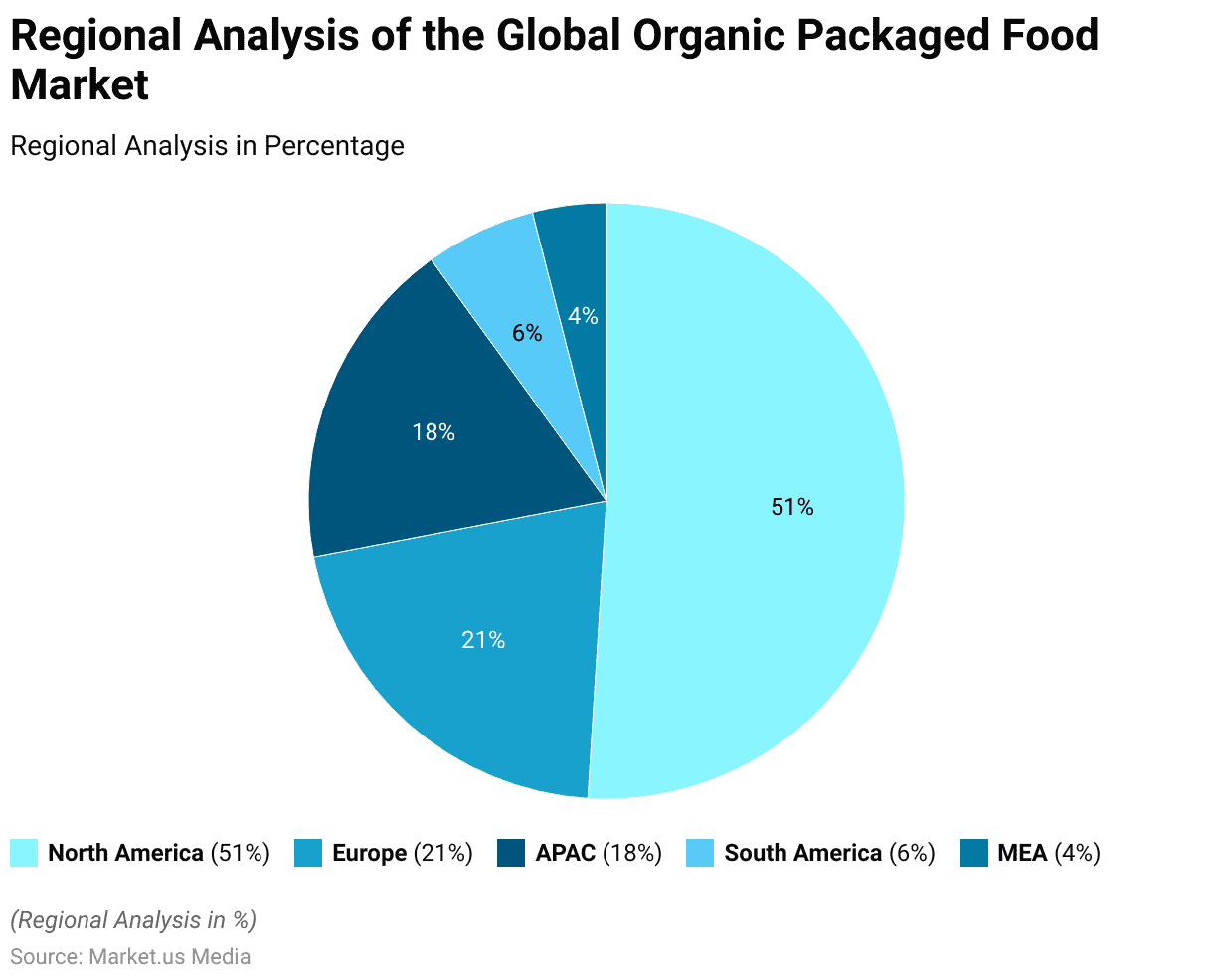
- In 2015, the share of organic packaged food within the overall sector in Germany varied significantly by product category.
- Organic baby food held the highest market penetration, comprising 33.58% of its overall sector.
- Organic spreads followed with an 8.51% share, while organic breakfast cereals accounted for 6.67%.
- Organic baked goods represented 4.77% of their sector, and organic dairy products constituted 4.39%.
- The share of organic oils and fats was 3.81%, and organic confectionery held 2.67%.
- Organic rice, pasta, and noodles made up 1.65% of their sector, with organic ready meals at 1.2% and organic biscuits and snack bars at 1.11%.
- This data highlights the varying degrees of market integration for organic products across different food categories in Germany.
(Source: Statista)
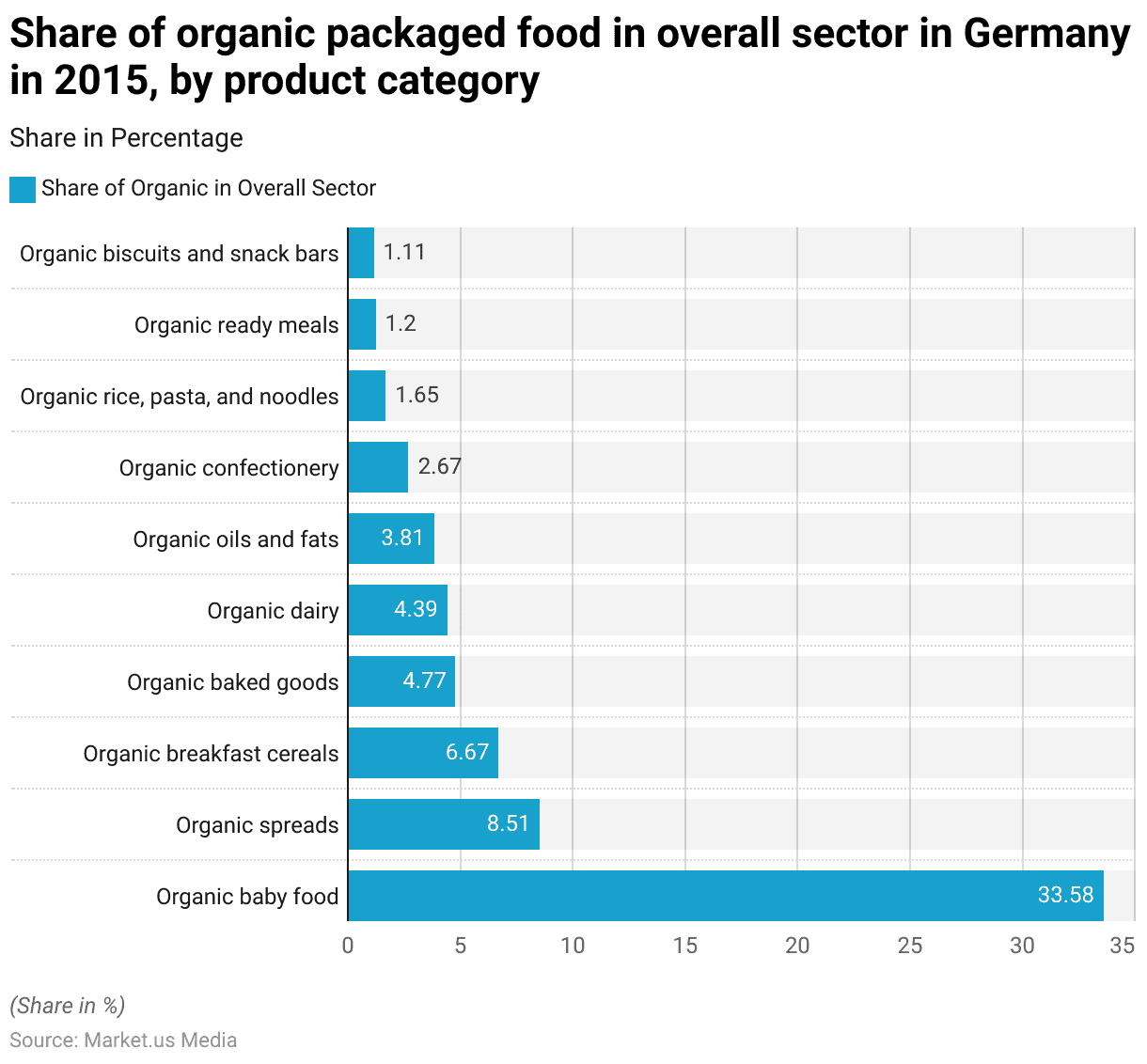
Leading Organic Packaged Food Brands – By Brand Awareness
- In 2023, the leading organic food brands in the United States, ranked by brand awareness, showcased notable market recognition.
- Trader Joe’s led with brand awareness of 72%, followed by Simply Organic at 67% and Simply Nature at 63%.
- Newman’s Own and Organic Valley were also prominent, with 59% and 58% awareness, respectively. Both 365 by Whole Foods Market and Stonyfield Organic achieved 46% brand awareness.
- Nature’s Path Organic was recognized by 42% of consumers, while Bob’s Red Mill had a 40% awareness.
- Earth Grown followed with 35%, and both Eden and Lundberg Family Farms had 29% awareness.
- NOW RealFood and Frontier Co-op rounded out the list with 26% and 25% brand awareness, respectively.
- This ranking highlights the varying degrees of consumer recognition across top organic food brands in the U.S. market.
(Source: Statista)

Global Organic Food Sales Statistics
Worldwide Sales of Organic Food
- The worldwide sales of organic food have demonstrated a notable upward trajectory over the past decade.
- In 2011, the market achieved sales of USD 62.9 billion, which increased to USD 70.8 billion in 2012.
- Despite a slight dip to USD 68.5 billion in 2013, the market rebounded to USD 80 billion in 2014 and further to USD 81.6 billion in 2015.
- The growth continued, with sales reaching USD 90 billion in 2016 and USD 97 billion in 2017.
- A minor decline occurred in 2018, bringing sales to USD 95 billion, but the market quickly recovered, achieving USD 106 billion in 2019.
- The COVID-19 pandemic saw a surge in demand for organic food, with sales soaring to USD 120.65 billion in 2020.
- This trend persisted in 2021, with sales rising to USD 132.74 billion, and in 2022, the market slightly increased to USD 134.6 billion, reflecting sustained consumer interest in organic products.
(Source: Statista)
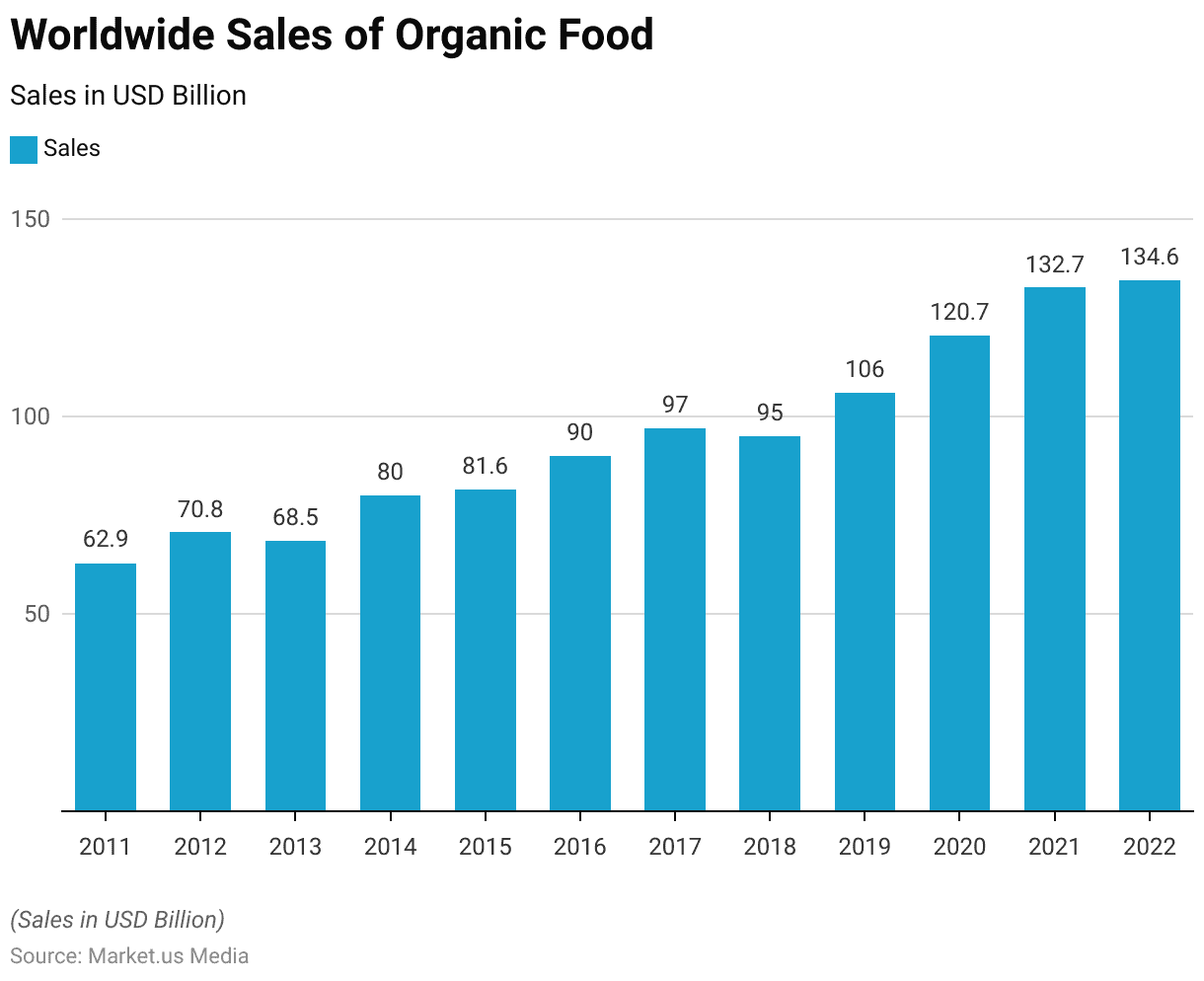
Global Organic Packed Food Retail Sales Statistics
- Between 2014 and 2018, global organic food retail sales exhibited significant growth across various regions.
- In North America, sales increased from 29 billion euros in 2014 to 44 billion euros in 2018, reflecting a robust compound annual growth rate (CAGR) of 20%.
- Europe also saw considerable growth, with sales rising from 26 billion euros to 41 billion euros, corresponding to a CAGR of 19%.
- In Asia, the market expanded from 5 billion euros to 10 billion euros, achieving a CAGR of 11%.
- The rest of the world (RoW) experienced growth from 1 billion euros to 2 billion euros, maintaining a CAGR of 11%.
- This data underscores the strong and consistent growth of the organic food market across these key regions.
(Source: FiBL Survey 2020)
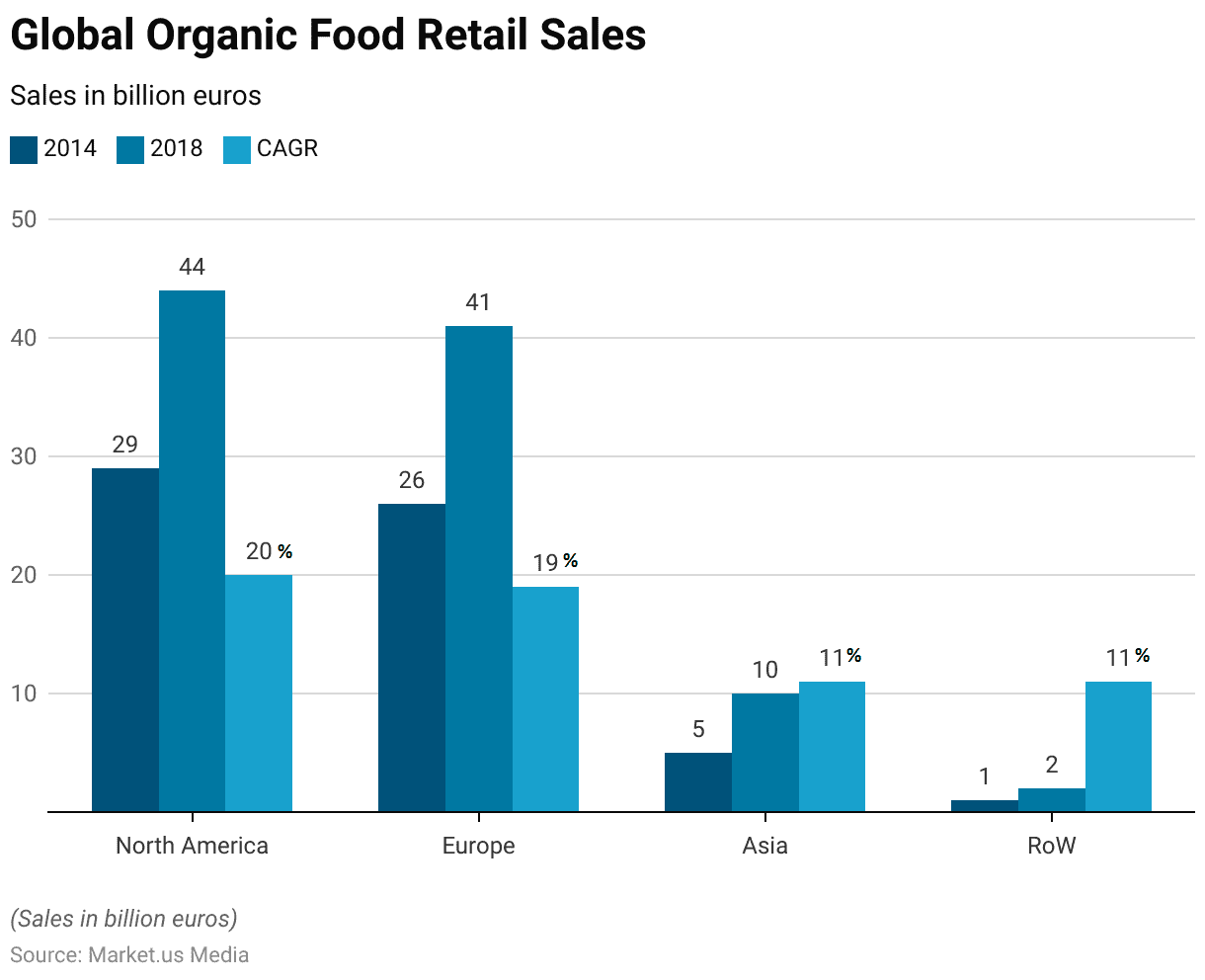
Organic Packaged Food and Beverage Consumption Statistics
- The forecast for organic packaged food and beverage consumption between 2018 and 2022 reveals diverse growth rates across various countries.
- Hong Kong leads with a robust compound annual growth rate (CAGR) of 17%, followed by India with a 14% CAGR and China with an 11% CAGR.
- France shows a solid growth rate of 10%, while Thailand is projected to grow at 8%.
- Italy and Spain are expected to see CAGRs of 7% and 6%, respectively, matching the growth rate of the United States.
- The United Kingdom anticipates a more modest growth, with a 4% CAGR.
- This forecast highlights the varying levels of market expansion for organic packaged food and beverages across different regions.
(Source: Global Organic Trade)
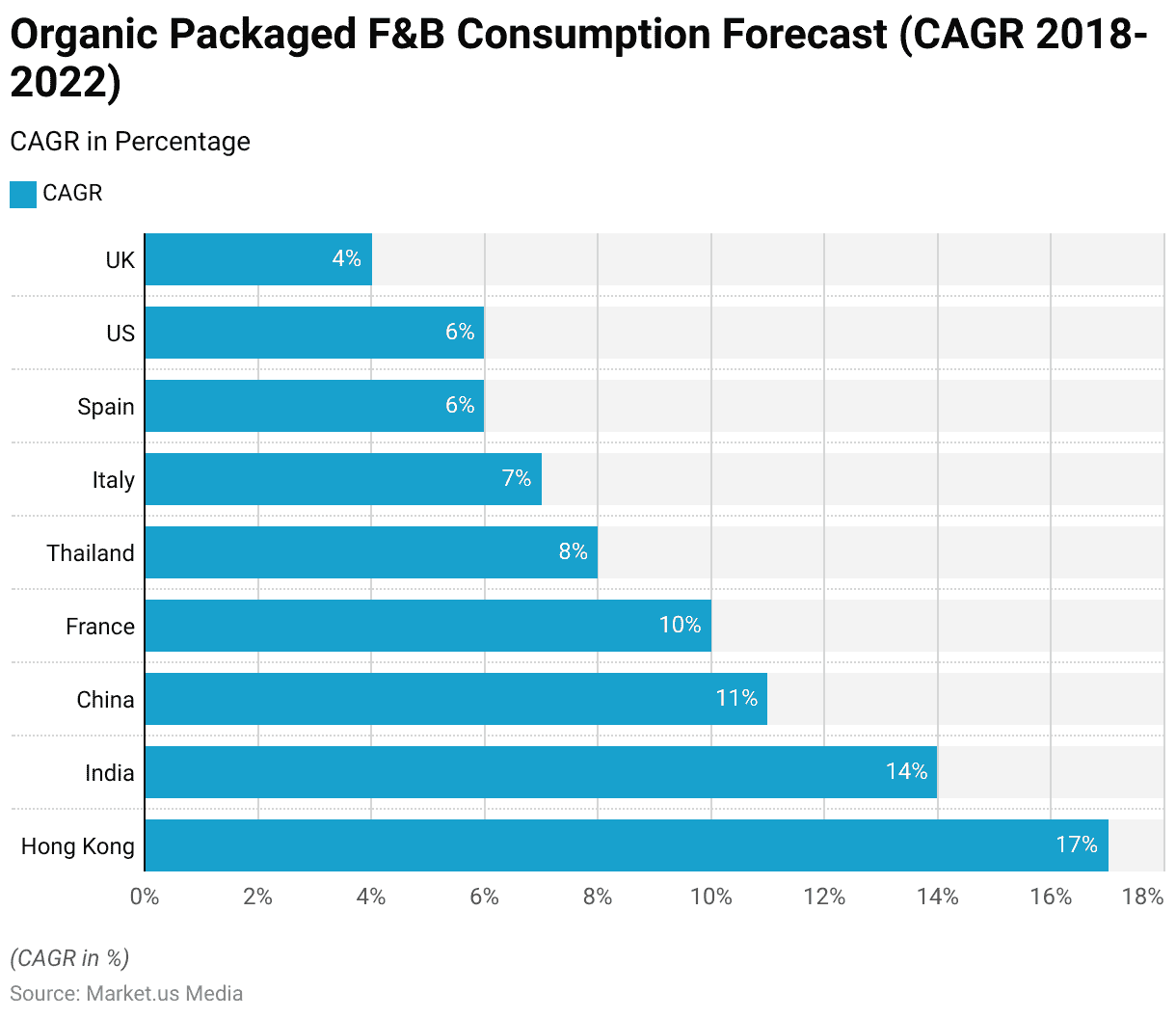
Local Certified Organic Food Produce Prices
- The prices for locally certified organic food produce vary between farmers’ markets and retail stores.
- At farmer’s markets, the price per pound for broccoli is USD 3.63, whereas in retail stores, it is slightly lower at USD 2.80.
- Carrots are priced at USD 3.00 per pound in farmers’ markets, comparable to USD 2.97 in retail stores.
- Chard is sold for USD 2.75 per pound at farmers’ markets and USD 2.80 in retail stores.
- Garlic, however, is more expensive at retail stores, priced at USD 9.80 per pound, compared to USD 8.00 at farmers’ markets.
- Kale is priced at USD 3.50 per pound at farmers’ markets and USD 2.80 in retail stores.
- Lettuce shows a marginal price difference, with USD 1.99 per pound at farmers’ markets and USD 2.00 in retail stores.
- Summer squash is USD 3.00 per pound at farmers’ markets, whereas it is significantly higher at retail stores, priced at USD 4.49.
- Tomatoes are USD 4.38 per pound at farmers’ markets and USD 5.98 in retail stores.
- Zucchini is priced at USD 2.90 per pound at farmers’ markets, while retail stores charge USD 4.49.
- This comparison highlights the price variations between purchasing organic produce at farmers’ markets versus retail stores.
(Source: U.S. Department of Agriculture)
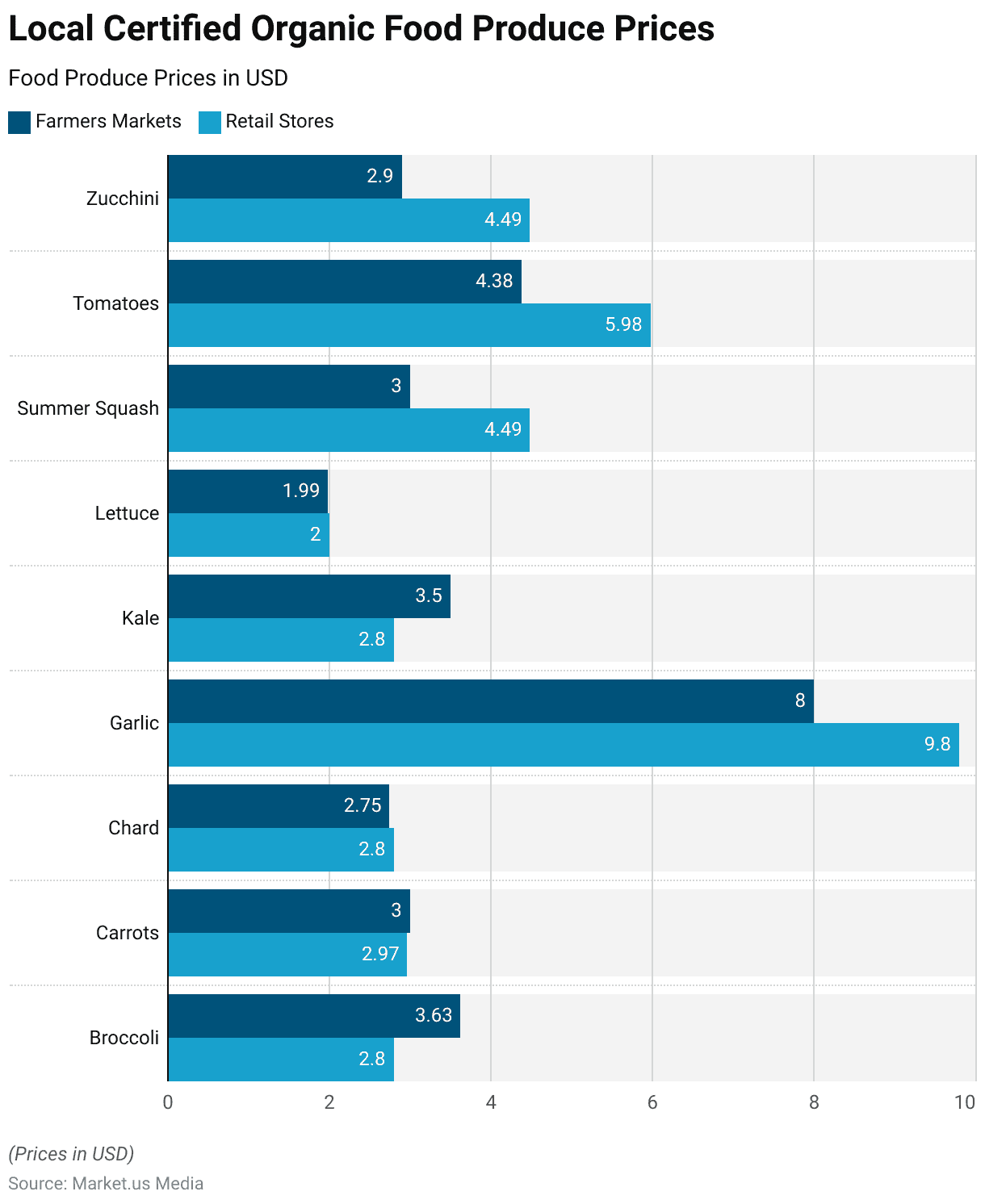
Leading Performers in The Organic Packaged and Prepared Food Category
- In 2012, the leading performers in the organic packaged and prepared food category in British Columbia (BC) were notably diverse.
- The soup category led the market with sales amounting to 5.09 million Canadian dollars.
- Baby food followed, generating 1.76 million Canadian dollars in sales.
- Tofu products also held a significant market position, with sales reaching 1.41 million Canadian dollars.
- Organic peanut butter achieved sales of 1.12 million Canadian dollars, while pasta sauce rounded out the category with 0.81 million Canadian dollars in sales.
- This data illustrates the varied consumer preferences and market strengths within the organic packaged food sector in BC.
(Source: Statista)
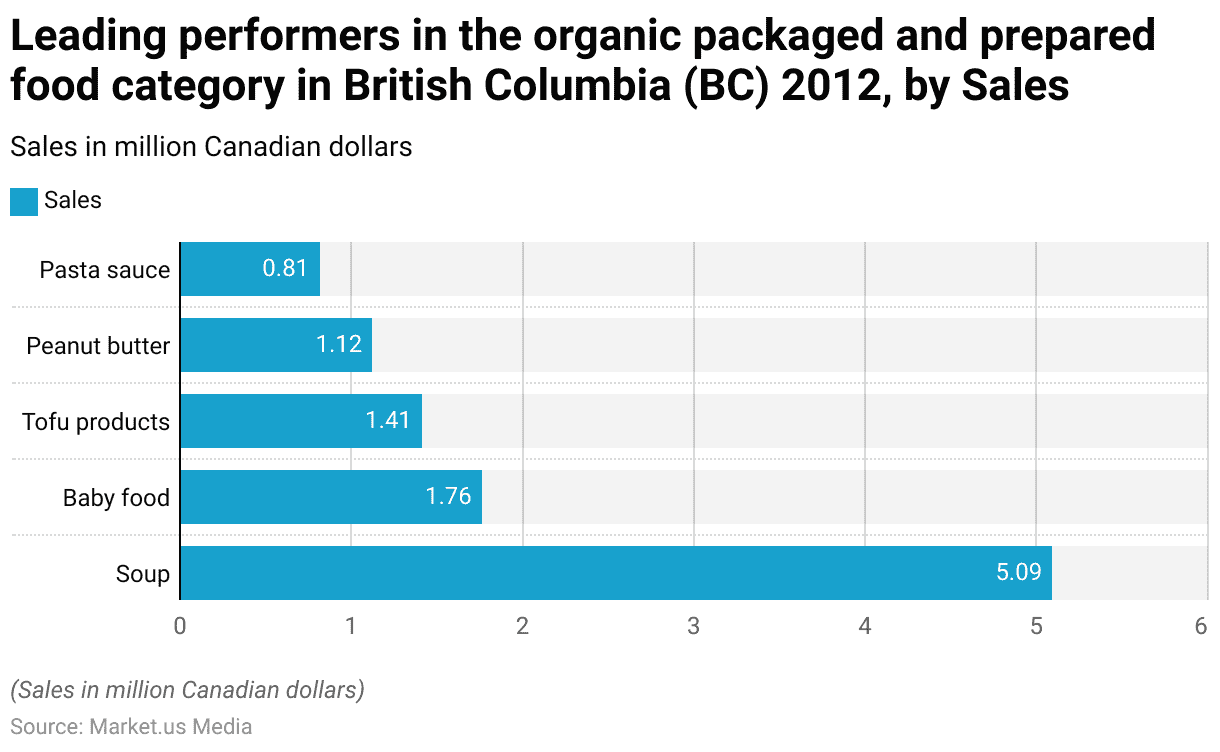
Demographics of Organic Packaged Food Consumers Statistics
By Age
- A survey on the perceptions of organic fruits and vegetables compared to conventionally grown produce among U.S. adults reveals significant age-based differences.
- Among the 18-29 age group, 61% believe organic produce is better for health, while 31% see no difference, and 8% consider it worse.
- In the 30-49 age group, 57% view organic as healthier, 40% perceive no difference, and 3% think it is worse.
- For those aged 50-64, 52% believe organic is better, 44% see no difference, and 2% consider it worse.
- Among adults aged 65 and older, 45% think organic produce is better for health, 50% see no difference, and 1% believe it is worse.
- This data illustrates a trend where younger age groups are more inclined to view organic produce as healthier compared to older age groups.
(Source: Pew Research)
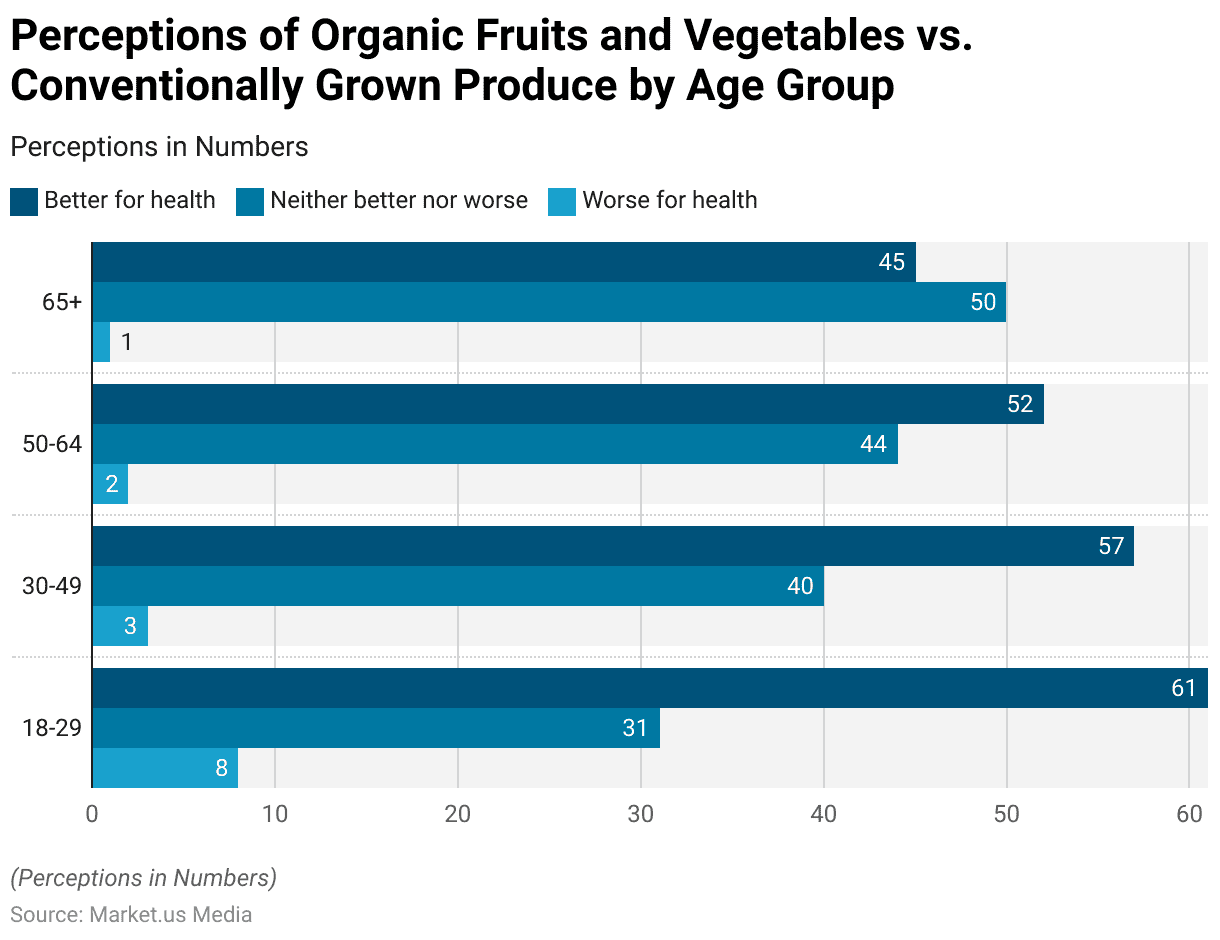
By Gender
- A survey examining the perceptions of organic fruits and vegetables versus conventionally grown produce among U.S. adults highlights gender differences in views.
- Among men, 51% believe organic produce is better for health, 44% think there is no difference, and 4% consider it worse for health.
- In contrast, 57% of women view organic produce as healthier, 38% see no difference, and 2% believe it is worse for health.
- This data indicates that women are more likely than men to perceive organic fruits and vegetables as better for health.
(Source: Pew Research)
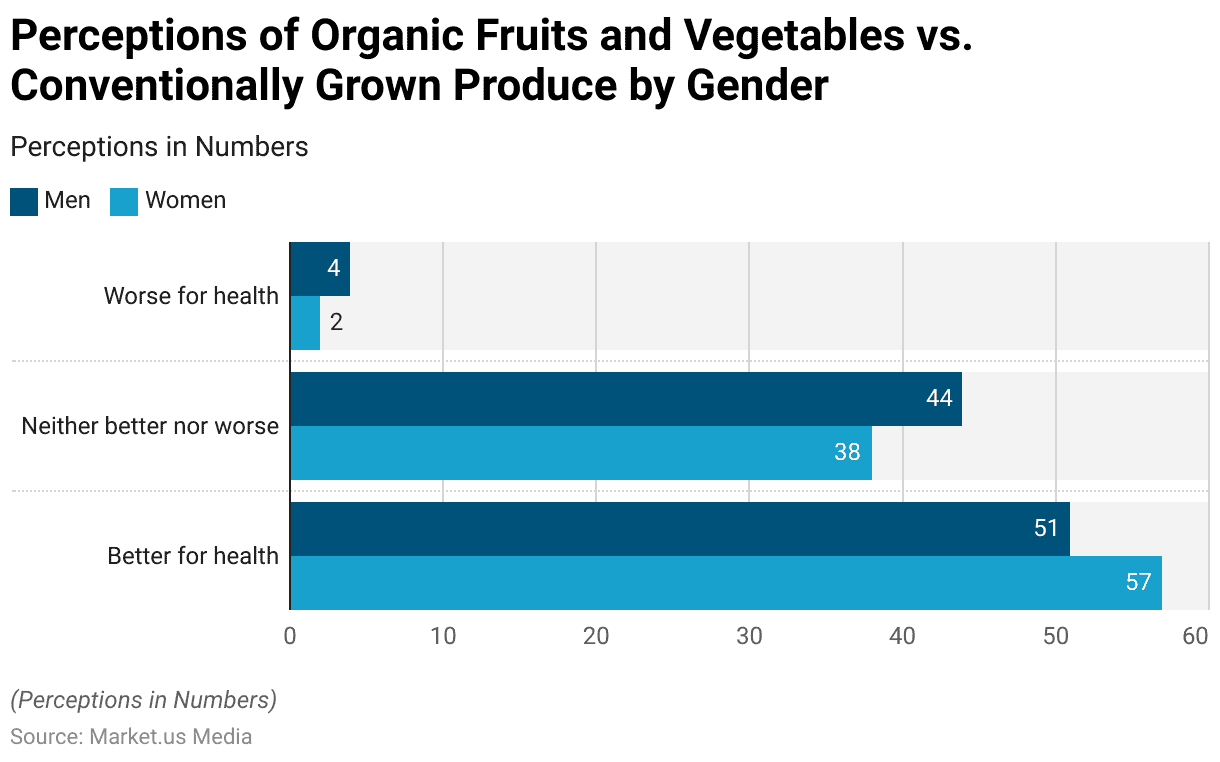
Consumer Behaviour and Perceptions
- The majority of Americans are opting for organic foods due to health concerns, with 55% believing organic fruits and vegetables are superior for one’s well-being.
- Additionally, 76% of those who purchased organic foods recently did so for health reasons.
- However, only 32% think organic produce tastes better than conventionally grown ones, while 59% believe they taste the same.
- Other motivations for buying organic, such as environmental benefits or convenience, are less prevalent, with 33% and 22%, respectively, citing these factors.
- While a majority of Americans (59%) believe organic produce tastes similar to conventionally grown produce, fewer individuals perceive a taste advantage for organic options.
- Among those who consume mostly or some organic foods, 51% believe organic produce tastes better, while 45% think it tastes about the same.
- Conversely, among those who rarely or never eat organic foods, 71% believe organic and conventionally grown produce taste the same, with only 20% stating a preference for organic produce’s taste.
- Of the individuals who purchased organic foods within the last month, 76% did so to obtain healthier food options.
- In comparison, a smaller percentage cited convenience (22%) or environmental considerations (33%) as motivations for their organic purchases.
(Source: Pew Research)
Challenges and Key Considerations
- Approximately 72% of American adults consider the price difference between organic and conventionally grown foods when deciding whether to purchase organic.
- Even regular organic consumers demonstrate cost sensitivity, with 65% of frequent consumers and 79% of less frequent consumers factoring in the comparative cost of organic foods when making purchasing decisions.
- Availability can influence organic food purchases, with 33% of Americans finding it very easy to locate organic options locally and an additional 48% stating they are easy to find.
- Conversely, 18% find organic foods hard to come by in their communities.
- Rural residents are less likely to find organic foods that are very easy to locate compared to urban and suburban dwellers.
- Nonetheless, 66% of rural Americans still find it easy or very easy to find organic foods locally, contrasting with 84% of urban residents and 85% of suburban residents.
(Source: Pew Research)
Regulations for Organic Packaged Food in Various Nations
- Regulations for organic packaged food vary significantly across different nations, reflecting diverse standards and consumer expectations.
- In the United States, the USDA’s National Organic Program (NOP) establishes comprehensive regulations, including production, handling, and labeling standards, with new rules enhancing animal welfare practices for organic livestock and poultry.
- The organic market in the U.S. has grown, with organic food sales reaching $57.5 billion in 2021, largely driven by fresh produce, which constitutes 40% of total organic food sales.
- In Europe, the EU Organic Regulation sets strict guidelines for organic production, covering everything from farming practices to food processing and labeling, aimed at ensuring consistency across member states.
- Globally, organic agriculture is practiced in 188 countries, with more than 96 million hectares of land managed organically, highlighting the widespread adoption of organic standards.
- These regulations are crucial in maintaining consumer trust and supporting the growing demand for organic products worldwide.
(Source: U.S. Department of Agriculture, Food and Agriculture Organization of the United Nations)
Recent Developments
Acquisitions and Mergers:
Hain Celestial Group has been active in expanding its portfolio through strategic acquisitions, targeting companies that enhance its organic and natural products range.
Nestlé has continued its push into organic foods by acquiring smaller, specialized brands to bolster its organic product line.
New Product Launches:
Amy’s Kitchen introduced a new line of organic, gluten-free frozen meals targeting health-conscious consumers and expanding their reach in the ready-to-eat segment.
General Mills launched several new organic cereal products under its Annie’s Homegrown brand, focusing on health and sustainability.
Funding and Investment:
The Canadian government committed approximately USD 103,400 to support the Organic Federation of Canada, aiming to advance sustainability and growth in the organic sector.
India has seen significant investment in organic food exports, with a substantial focus on increasing production for global markets, particularly the U.S. and EU.
Market Expansion:
The online sales channel for organic packaged foods is growing rapidly, with a projected CAGR of 15.2% from 2024 to 2030, driven by increased internet penetration and targeted marketing.
Asia-Pacific markets, especially India and China, are experiencing significant growth in demand for organic packaged foods, with India projected to grow at a CAGR of 21% from 2024 to 2030.
Trends in Sustainability:
There is a rising consumer preference for sustainable and eco-friendly packaging solutions, aligning with the broader trend towards environmental consciousness in the organic food market.
Technological Advancements:
Companies are increasingly adopting innovative technologies to enhance product shelf-life and maintain the nutritional value of organic packaged foods.
Conclusion
Organic Packaged Food Statistics – The organic packaged food market is growing rapidly due to rising consumer interest in health and sustainability.
This growth is bolstered by stringent global regulations ensuring product quality and integrity. In the U.S., the USDA’s National Organic Program (NOP) provides comprehensive standards that enhance consumer trust and market competitiveness.
Similarly, the EU’s strict organic regulations ensure consistency across Europe. With organic farming practiced in 188 countries covering over 96 million hectares, the sector is well-positioned for continued growth and innovation to meet evolving consumer demands.
FAQs
Organic packaged food refers to food products that are produced, processed, and packaged following specific organic farming standards. These standards typically prohibit synthetic pesticides, chemical fertilizers, genetically modified organisms (GMOs), and artificial additives.
Various national and international bodies regulate organic packaged foods. In the U.S., the USDA’s National Organic Program (NOP) sets the standards. In Europe, the EU Organic Regulation governs organic food production and labeling. These regulations ensure the authenticity and quality of organic products.
Organic packaged foods often have fewer pesticides no GMOs, and are produced using methods that promote ecological balance and conserve biodiversity. Consumers also perceive them as healthier and more environmentally friendly.
Yes, organic packaged foods generally have a price premium compared to conventional foods. This is due to higher production costs, stricter regulatory requirements, and more labor-intensive farming practices.
Common types include organic fruits and vegetables, dairy products, meats, grains, snacks, and beverages.
Discuss your needs with our analyst
Please share your requirements with more details so our analyst can check if they can solve your problem(s)



